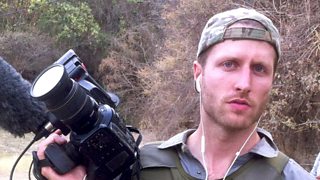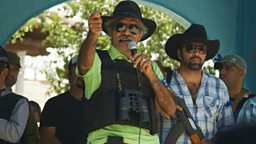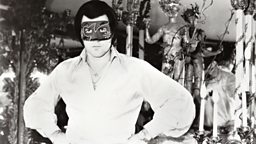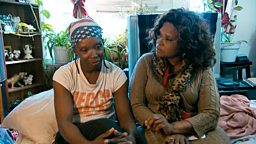Cartel Land
Matthew Heineman is a New York-based Emmy-nominated filmmaker. He has previously directed feature length documentaries Escape Fire: The Fight to Rescue American Healthcare (2012) and Our Time (2009).

What is more important, story or character?
They are equally important and, actually, I think two sides of the same coin. In my opinion, you can’t have a compelling story without a compelling character and vice versa.
What made you first want to explore the subject?
I was riding the New York subway and reading Rolling Stone magazine. Damon Tabor’s article “Border of Madness” completely grabbed me. It explored a group of American vigilantes patrolling the Arizona border, and I was struck by how little I knew about the US/Mexico border, drug cartels, and vigilantism. These were all things that fascinated me.
How long did it take to get the film off the ground?
Thinking there might be a film in the story, I reached out to Tabor, who introduced me to one of the primary characters in the article, “Nailer,” a self-appointed American border vigilante. But Nailer was wary of the media, and it took months for me to gain his trust.
I began shooting in Arizona in June of 2013, taking two or three trips to Arizona over a four-month period. I had no intention of expanding the scope of the narrative outside the United States until my father randomly sent me a Wall Street Journal article about the Autodefensas, a citizen uprising against the violent Knights Templar drug cartel that has wreaked havoc in the Mexican state of Michoacán for years. Suddenly, I knew I wanted to change the film to be about vigilantism on both sides of the border. More research led me to a Washington Post article about Dr. José Manuel Mireles, a small-town physician known as "El Doctor," who was the charismatic leader of the Autodefensas movement.
While it had taken months to win the trust of Nailer and his guys, I was in Mexico filming Mireles and the Autodefensas within two weeks of my first contact. Once we had the blessing of the doctor, we pretty much had carte blanche access to the rest of the Autodefensas movement. But it was 9 months of filming (1 or 2 weeks each month) and developing rapport with my subjects that allowed me to get the intimacy and access to ultimately tell the story in the way I did. I’m not a war reporter, and I’ve never filmed in dangerous conditions before. But, in the process of making CARTEL LAND, I found myself in shootouts between the vigilantes and the cartel, meth labs, torture chambers, places I could have never imagined filming in.
What were you most surprised to learn in the course of production?
The more time I spent down there, the more complex the story became: it was partly an ascent of people seeking to fight evil and partly a descent into hell as they took the law into their own hands, with many twists and turns in between. It is about elemental issues of order and chaos, of the desire for law but also of terrifying brutality and lawlessness.
At first, I tried to sniff out what was really happening, who these guys truly were, where the movement was going, what the endgame was. And what I originally thought was a very simple story, especially on the Mexican side, was in fact much more complex and much more grey. I became even more motivated, almost obsessed, as the lines between good and evil became ever more blurred and the story progressed in dramatic and unexpected ways.
It is this moral ambiguity that intrigues me most, and it emerges naturally in the story and in our characters. The film doesn't offer simple answers and, instead, presents a narrative that I believe will be interpreted and understood in many different ways. In a sense, CARTEL LAND is a cautionary tale of what happens when men and women take up arms in a lawless society. For me, it is a timeless story of the conflict between idealism and violence, which has eerie echoes throughout history and across the world today.
What have been the differences in reception to the film in countries it has now travelled to?
I have been humbled and moved by responses from people around the world. In Mexico, this is a topic that dominates the headlines, but the film seemed to strike a deep emotional cord by providing a visceral window into the violence and corruption that people read or hear about every day or see glorified in movies or TV. In Colombia, given their history with cartels and paramilitary groups, the film resonated deeply. In the U.S. the film elicited many responses, but one that I never expected: at numerous screenings, drug addicts have come up to me, crying, saying that family members had tried for years to get them to stop, but that, for some reason, seeing the violence that their habits were perpetuating had a profound and poignant impact.
Which documentary has most inspired you?
I feel like I’ve drawn inspiration from so many different films, for different reasons. But for this film, The Square and Restrepo were big inspirations.
Favourite Website/blog?
;
Best piece of filmmaking advice you’ve ever been given?
I heard Al Maysles once say, “If you end up with the story you started with, then you weren’t listening along the way.” I think that this is good advice for life and also good advice for filmmaking, and it’s something that I thought about almost every day during the making of Cartel Land.
Best piece of filmmaking equipment you can’t live without?
I mainly shot Cartel Land with the Canon C300. That camera was dropped, smashed, hit by guns, smothered by dust storms, pelted by torrential rain, and it never, ever failed. Given the situations we were in, I kept the camera very small: body, lens, Schoep's CMIT 5 Shotgun Microphone, and a Diety Miera viewfinder (which was a must given the bright sunshine we were constantly shooting in). Given how important sound is for documentaries, I would probably say the Schoep’s was the most key piece of equipment because it allowed me to be small and nimble (without a soundman) and still get really, really good sound. I was truly astounded at how I could cover a big crowd scene with just that mic.
If money was no object, what is your dream documentary subject?
I’ve always wanted to make a music documentary, following a band or an artist in real time before they make it big, seeing how fame effects them, and then following them for many years to see where their life goes. These longitudinal films are very hard films to fund, but it’s something that I’m currently developing and excited about.
Favourite film of all time?
Good Will Hunting
Most difficult access?
From the moment I stepped foot in Michoacán, Mexico, my goal was to shoot in a meth lab, and I knew I wanted to begin the film there. Meth is the main source of the Knights Templar’s power. It is their cash cow. It is their lifeblood. In fact, 90 percent of meth consumed in the U.S. comes from Mexico, most of it from the Templars.
It was very important to capture this aspect of the story, and we tried for months to get into a lab. Every shoot I would try to find somebody who knew somebody who knew somebody who cooked. Amongst our vast network of people down there, we thought we had a guy who could hook it up, and he kept telling us to be patient and promised to make it happen.
Finally, last summer we were on one of our final shoots. It was one of those days when nothing was going right. Our car had broken down in the middle of the mountains in a dangerous area controlled by the cartel. But then, at last, the call came. “Be in this town square at 6 p.m. sharp,” they said.
I like shooting with a small crew and, at this point, it was three of us: my fixer, my translator, and me. My fixer quickly established the ground rules with our meth contact. We would not be blindfolded and, in exchange, they required that everyone we film wear a mask. We promised not to show anybody’s face.
We drove through the mountains and made it to the town with minutes to spare. A pair of armed men asked if we were ready and told us to follow them. With the sun dropping rapidly, they drove us down a highway, off the highway, through towns and then small villages, which eventually gave way to vast, open farmlands.
Suddenly, in the middle of one of these fields, our “guides” stopped and told us that they weren’t going any further. They would stay there to provide protection. Protection from whom, we wondered? The Autodefensas, the government, the federales? Another car full of men drove from out of nowhere, and they said that they would lead us into the lab.
For months, I had dreamed about how I wanted to shoot the meth scene, and the whole time, I envisioned shooting it during the day or in a trailer-like building. But, when we got there, the last rays of light were falling beneath the mountains in the distance. The head chef – a small, fiery man – started showing us the lab. And that’s when I realized that the lab wasn’t like something from “Breaking Bad.” Instead, it was outside, hidden amidst a dense forest of trees, in pitch-black darkness.
That was a big problem since I don’t shoot with lights (nor would they have allowed me to use them because darkness was the key to operating a mobile meth lab and not getting caught). To keep us from tripping over the dense brush, the head chef, surrounded by big burly men with assault rifles, used a flashlight to show us the way. And it was with this flashlight that I lit the scene.
Over the course of two hours, I filmed the lab and the process of meth cooking. The big burly men with assault rifles carried in containers of pure alcohol from a truck that soon arrived. Then, barrels of methanol were rolled in and mixed with crystal-looking substances. Eventually, all of the ingredients were put into large blue barrels, and the big burly men with assault rifles stirred them with large sticks, like some witch’s concoction.
At this point, it was just after 10 p.m. and, as a team, we had agreed that we wouldn’t stay too late. With time ticking, I needed to quickly set up my interview with the head chef. We found an empty barrel to sit him on, but his men were milling about and creating a ton of noise – making it almost impossible to get clean sound that could be used as voiceover. I asked him to ask them to be quiet, and he ordered them to stand still. At this point, they were all standing behind him, so I had my fixer light them from the side with one flashlight and my translator sat beside me holding a boom in one hand and the second flashlight, which illuminated the head chef’s face, in the other hand.
As the barrels sizzled and smoke billowed into the air and the cacophonous sounds of cicadas rose and fell with an arrhythmic beat and huge alien-like bugs crawled down our necks and inside our clothes, I talked to the head chef and he told me:
The United States is where most of the drugs are sold. All over the United States.
What can I say?
We know we do harm with all the drugs that go there.
But what are we going to do?
We come from poverty. If we were doing well, we would be like you.
Traveling the world or doing good clean jobs like you guys…
But if we start paying attention to our hearts, then we’ll get screwed over.
We will do this as long as God allows it.
As long as He allows it, we will make drugs.
And every day we will make more because this is not going to end, right?
What do you think, guys?
He then turned around to the big burly men with assault rifles and they said in refrain:
I hope not.
Of course not!
The good stuff is about to begin.
Just before midnight, my fixer told me that it was time to leave. We were escorted out of the forest into the fields, past the villages and towns, and onto the highway.
Best recent read?
Gangster Warlords by Ioan Grillo



